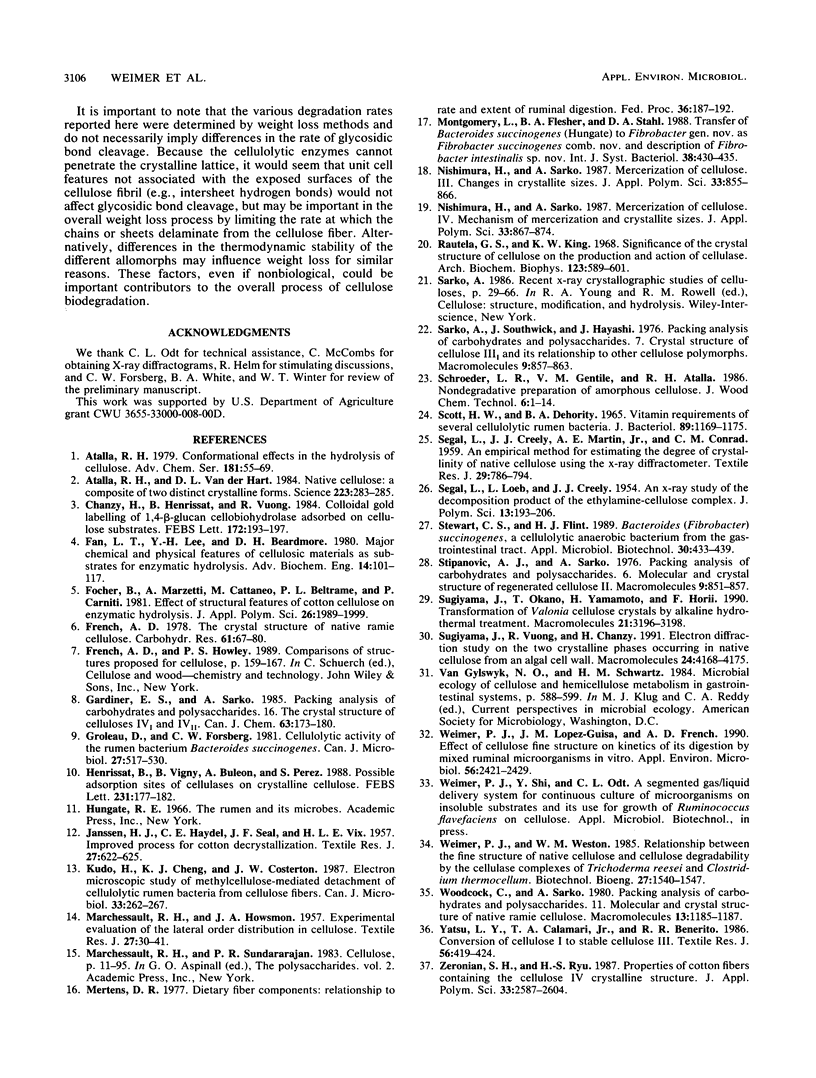Abstract
In addition to its usual native crystalline form (cellulose I), cellulose can exist in a variety of alternative crystalline forms (allomorphs) which differ in their unit cell dimensions, chain packing schemes, and hydrogen bonding relationships. We prepared, by various chemical treatments, four different alternative allomorphs, along with an amorphous (noncrystalline) cellulose which retained its original molecular weight. We then examined the kinetics of degradation of these materials by two species of ruminal bacteria and by inocula from two bovine rumens. Ruminococcus flavefaciens FD-1 and Fibrobacter succinogenes S85 were similar to one another in their relative rates of digestion of the different celluloses, which proceeded in the following order: amorphous > IIII > IVI > IIIII > I > II. Unlike F. succinogenes, R. flavefaciens did not degrade cellulose II, even after an incubation of 3 weeks. Comparisons of the structural features of these allomorphs with their digestion kinetics suggest that degradation is enhanced by skewing of adjacent sheets in the microfibril, but is inhibited by intersheet hydrogen bonding and by antiparallelism in adjacent sheets. Mixed microflora from the bovine rumens showed in vitro digestion rates quite different from one another and from those of both of the two pure bacterial cultures, suggesting that R. flavefaciens and F. succinogenes (purportedly among the most active of the cellulolytic bacteria in the rumen) either behave differently in the ruminal ecosystem from the way they do in pure culture or did not play a major role in cellulose digestion in these ruminal samples.
Full text
PDF





Selected References
These references are in PubMed. This may not be the complete list of references from this article.
- Fletcher C. D., Farish E., Hart D. M., Lindsay R., Sharpe G. L. Lipoprotein levels during hormone replacement therapy by vaginal ring pessaries. Br J Obstet Gynaecol. 1984 Mar;91(3):283–285. doi: 10.1111/j.1471-0528.1984.tb04769.x. [DOI] [PubMed] [Google Scholar]
- Groleau D., Forsberg C. W. Cellulolytic activity of the rumen bacterium Bacteroides succinogenes. Can J Microbiol. 1981 May;27(5):517–530. doi: 10.1139/m81-077. [DOI] [PubMed] [Google Scholar]
- Kudo H., Cheng K. J., Costerton J. W. Electron microscopic study of the methylcellulose-mediated detachment of cellulolytic rumen bacteria from cellulose fibers. Can J Microbiol. 1987 Mar;33(3):267–272. doi: 10.1139/m87-045. [DOI] [PubMed] [Google Scholar]
- Mertens D. R. Dietary fiber components: relationship to the rate and extent of ruminal digestion. Fed Proc. 1977 Feb;36(2):187–192. [PubMed] [Google Scholar]
- Rautela G. S., King K. W. Significance of the crystal structure of cellulose in the production and action of cellulase. Arch Biochem Biophys. 1968 Mar 11;123(3):589–601. doi: 10.1016/0003-9861(68)90180-x. [DOI] [PubMed] [Google Scholar]
- SCOTT H. W., DEHORITY B. A. VITAMIN REQUIREMENTS OF SEVERAL CELLULOLYTIC RUMEN BACTERIA. J Bacteriol. 1965 May;89:1169–1175. doi: 10.1128/jb.89.5.1169-1175.1965. [DOI] [PMC free article] [PubMed] [Google Scholar]
- Weimer P. J., Lopez-Guisa J. M., French A. D. Effect of cellulose fine structure on kinetics of its digestion by mixed ruminal microorganisms in vitro. Appl Environ Microbiol. 1990 Aug;56(8):2421–2429. doi: 10.1128/aem.56.8.2421-2429.1990. [DOI] [PMC free article] [PubMed] [Google Scholar]


